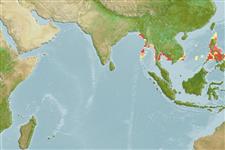Пластиножаберные (акулы и скаты) (sharks and rays) >
Orectolobiformes (Carpet sharks) >
Hemiscylliidae (Bamboo sharks)
Etymology: Chiloscyllium: cheilos (Gr.), lip, referring to membranous and broad lower lip, presumably of C. plagiosum (proposed without a species); skylion, Greek for dogfish or small shark (See ETYFish); hasseltii: In honor of Dutch physician and biologist Johan Coenraad van Hasselt (1797-1823), who explored the colonial Dutch East Indies with his friend Heinrich Kuhl in 1820 (See ETYFish).
Eponymy: Dr Johan Coenraad van Hasselt (1797–1823) was a Dutch physician, zoologist, botanist and mycologist. [...] (Ref. 128868), visit book page.
More on author: Bleeker.
Environment: milieu / climate zone / depth range / distribution range
экология
морской ассоциированный с рифами; пределы глубины 0 - 12 m (Ref. 90102). Tropical; 23°N - 10°N, 91°E - 133°E
Indo-West Pacific: Thailand, Singapore, Malaysia, Indonesia, Myanmar and Vietnam.
Size / Вес / Возраст
Maturity: Lm ? range ? - ? cm
Max length : 61.0 cm TL самец/пол неопределен; (Ref. 106604)
колючие лучи спинного плавника (общее число) : 0; колючие лучи анального плавника: 0. Caudal fin with a pronounced subterminal notch but without a ventral lobe (Ref. 13575). Juveniles with dark grey-brown bands outlined in black, adults uniform medium- to dark-brown color, the black edgings being the last parts of the color pattern to disappear (Ref. 13575).
A common inshore bottom-dweller (Ref. 13575); on rock and coral reefs (Ref. 90102). Feeds on invertebrates (Ref. 13575). Oviparous (Ref. 50449). Utilized for human consumption (Ref. 13575). Minimum depth from Ref. 58018.
Life cycle and mating behavior
половая зрелость | размножение | нерест | икра | Fecundity | личинки
Oviparous, paired eggs are laid. Embryos feed solely on yolk (Ref. 50449). Distinct pairing with embrace (Ref. 205).
Compagno, L.J.V. and V.H. Niem, 1998. Hemiscylliidae. Longtail carpetsharks. p. 1249-1259. In K.E. Carpenter and V.H. Niem (eds.) FAO identification guide for fishery purposes. The Living Marine Resources of the Western Central Pacific. FAO, Rome. (Ref. 13575)
Статус Красного Списка МСОП (Ref. 130435: Version 2024-1)
Угроза для людей
Harmless
Использование человеком
рыболовство: коммерческий
дополнительная информация
инструменты
Специальные отчеты
Скачать в формате XML
ресурсы в Интернет
Estimates based on models
Preferred temperature (Ref.
123201): 27.9 - 29.1, mean 28.7 °C (based on 158 cells).
Phylogenetic diversity index (Ref.
82804): PD
50 = 0.5039 [Uniqueness, from 0.5 = low to 2.0 = high].
Bayesian length-weight: a=0.00398 (0.00176 - 0.00901), b=3.09 (2.89 - 3.29), in cm total length, based on LWR estimates for this (Sub)family-body shape (Ref.
93245).
Trophic level (Ref.
69278): 3.5 ±0.37 se; based on food items.
устойчивость к внешним воздействиям (Ref.
120179): низкий, минимальное время удвоения популяции 4.5-14 лет (Fec assumed to be <100).
Fishing Vulnerability (Ref.
59153): Moderate vulnerability (44 of 100).
